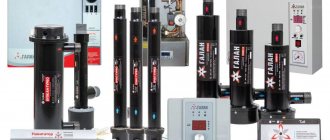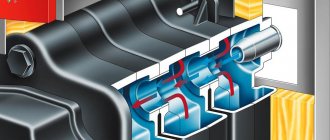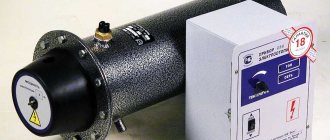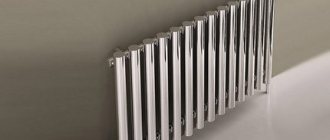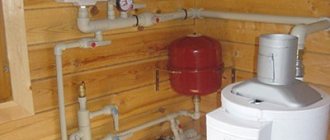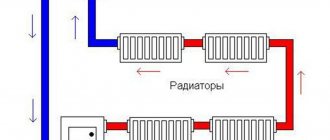Today, there are many options for arranging individual heating for a private home. And if some homeowners prefer gas or solid fuel boiler models, others believe that nothing better than electric heating systems has yet been invented. In addition, in the context of constantly rising prices for energy resources, any prudent owner begins to think about ways to reduce utility costs and choose a truly effective and cost-effective heat source. Fortunately, modern manufacturers provide everyone with this opportunity.
As an alternative to today's popular heating systems, ion, or, as they are also called, electrode boilers have long attracted the attention of potential buyers. Thanks to the unique method of heating the coolant in the system, they have a number of advantages compared to traditional heating equipment.
Historical excursion
First appearing in the mid-twentieth century, such boilers were used by enterprises of the Soviet defense complex for the needs of the Navy. The compact size of the ion boiler was an ideal model for operation in the limited conditions of the ship. The unit fully coped with its task, worked almost silently, and the role of the coolant in it was performed by sea water.
In the early 90s, the number of orders for the defense industry from the state sharply decreased, and such a successful development for its time as an electric ion heating boiler was not in demand. But engineers A.P. Ilyin used it. and Kunkov D.N., who modified the boiler to an improved “civilian” version and received a patent for their “brainchild” in 1995.
Design features
An ion electrode boiler differs from a conventional boiler in the absence of a heating element, and therefore the heating of the system is carried out entirely due to the characteristics of the special coolant. Instead of a heating element, a block with electrodes is installed in the unit, which serves as the main heating element. Such a replacement made it possible to solve the problems of fragility and low efficiency associated with the operation of most electric boilers.
Despite the seemingly primitive design, the ion heating boiler boasts fairly high efficiency, practicality in use and an almost zero accident rate, which for many private homeowners are decisive factors in favor of choosing such a unit. In addition, if you have the desire and some experience, you can make an ionic electric boiler with your own hands. It is enough to understand the principle of its operation, familiarize yourself with a schematic representation of the design and prepare the necessary materials and tools.
So, externally, such a boiler is a solid steel pipe coated with a layer of polyamide. The following are connected to the product body:
- • coolant inlet/outlet pipes;
- • power supply and grounding terminals;
- • electrode made of a special alloy and insulated with polyamide nuts;
All connector locations are equipped with additional protection against current leakage with rubber gaskets. As you can see, special attention is paid to electrical insulation.
A number of manufacturers equip their ion boilers with automatic control systems. It is the controllers, which include built-in protection against power surges in the network, a starter unit and an electronic thermostat, that allow you to maintain the specified temperature of the coolant, thereby reducing energy consumption. Control can be either direct or remote using GSM channels (in more expensive models).
As for the principle of coolant movement inside the boiler, there are closed and open ion boilers.
Types of malfunctions of electric heating boilers
Problems in the electric boiler circuit
Since various metals and salts are almost always dissolved in the coolant, sooner or later under the influence of temperature they will precipitate and accumulate inside pipes and radiators.
This leads to a decrease in clearance, poor thermal conductivity, corrosion and other consequences that reduce the efficiency of the heating system. In order for the batteries to always be warm, it is necessary to periodically - once every 1-2 years - flush the circuit. Since scale mainly forms in electric boilers, the easiest way to remove it is with a solution of citric acid. To do this, you need to replace the coolant with it and let the system run for several hours, then drain and rinse in the same way with ordinary water. These actions are sufficient to protect the metal and provide good heating.
The second problem associated with the circuit is airing. Air is produced due to cracks, poorly tightened taps, boiling over or cavitation. When there is too much of it, the boiler begins to heat the coolant worse and worse, and the wear of parts increases. You can check the pressure in pipes either with a pressure gauge built into the equipment or with remote instruments.
Most modern systems have special valves that allow excess air to be released. If there are none, then they can be installed separately. Having released the gas, you need to add coolant to the norm.
Noise during operation of the electric boiler
Most often, the first sign of an impending breakdown is the non-standard sounds that the electric boiler makes. By the type of noise that comes from the circuit and the boiler itself, you can understand what exactly is going wrong:
- Knocks - mainly occur due to the accumulation of scale and its separation from the walls. It can also occur when dirt filters are clogged.
- The pipes are humming - the lumen of the pipes is narrowed, there is insufficient coolant. It is quite possible that there is a leak somewhere.
- Hissing is a decrease in the volume of coolant due to its boiling. Too hot water leads to just such sounds.
First of all, when noise appears, it is necessary to check the circuit for leaks. The cause of overheating and airing is most often a lack of water, which is why the heat from the heating element or electrodes goes not into the water, but into the metal. This effect reduces the service life of key boiler parts and leads to breakdown. The coolant “leaves” from the circuit most quickly during leaks.
If there are no cracks or chips, then it is worthwhile to diagnose the temperature sensor and pressure sensor. This is done using the control unit by checking the data on the display: if they show non-standard numbers, you need to ring the sensors with a tester. If there is a break in the internal network, the contacts must be soldered back. If the sensor is faulty, replace it entirely.
Temperature drop in an electric boiler
If the temperature in the boiler decreases gradually, this indicates that the heat exchanger is clogged. It is in this part that heating occurs, which is why scale forms most of all here. Cleaning the heat exchanger at home can be done in three ways:
- Mechanical cleaning of the heat exchanger. You need to remove the front panel and remove the heat exchanger (depending on the design, you may need to dismantle the entire system). Next, unscrew the 4 bolts on its cover and clean the metal plates with a special brush, then rinse them thoroughly with water or a chemical solution. After this, you can assemble the heat exchanger and start the boiler.
- Chemical cleaning of the heat exchanger. An alternative method is to dissolve scale with citric acid. Repeating steps from step 1, you need to remove the heat exchanger and place it in a container with a solution for several hours. In this case, you can either disassemble the part itself or place it in liquid as a whole. Then the heat exchanger needs to be washed with water and returned to its place.
- Cleaning the heat exchanger with a booster. The easiest way to clean it is to connect a booster to the circuit - a device for pumping liquid under pressure in both directions. In this case, the heat exchanger itself does not need to be removed. The booster is filled with the same solution and begins to drive liquid through the heat exchanger. Literally after a couple of hours, the purifier is replaced with water, washed, and the boiler can be connected back. The main advantage of this method is the parallel cleaning of the coil (with a certain connection) and other pipes.
If after carrying out these procedures the problem is not resolved, then the cause may be a weak power supply. You can check it on the display of the boiler itself. This often happens if the electric boiler is not connected directly through the panel, but using a power cable and socket. In this case, it is worth making a direct connection of the equipment to the current source and replacing the aluminum cables with copper ones. Current stability can also be ensured by an additional generator or UPS.
Electric boiler does not turn on
The boiler may not start for many reasons, but most often the problem lies in the electrics. This or that element blocks the system and prevents it from working. This could be a thermal relay or a pressure sensor, which themselves “tell” the system about malfunctions. Therefore, you can check this version using the error indicators on the control panel.
If you cannot find out the specific location of the breakdown, then you need to ring the contacts of each unit. Contacts often break, therefore, having found a fault, you should solder them or replace the part.
The circulation pump is also often a source of trouble. If for some reason it does not work, then the boiler will not turn on. The impeller in it may stop rotating due to airing, blockage, wheel locking or damage. To check the pump, you need to unscrew the bolt on the cover, drain the water, inspect the parts, troubleshoot problems, turn the crankshaft with a screwdriver and put everything back together.
Electric boiler does not turn off
Electric boilers have sensors that monitor the temperature of the coolant and various parts. In case of overheating, the automation should stop the operation of the equipment. If the water becomes too hot, and the boiler continues to heat, then a malfunction of the thermostat or fuses is obvious.
To check the electrics, you need to remove the cover of the control unit and inspect the parts. It’s also worth sniffing: burnt wiring has a characteristic pungent odor, and it can indicate the location of the damage. The sensor contacts should be tested with a tester, and burnt fuses should be replaced.
Also, the reason may lie in the failure of the pressure sensor. If there is little coolant in the circuit, the system should turn off, but if there is an electrical problem, this may not happen. You need to check the pressure using a pressure gauge, check the sensor for functionality and, if necessary, replace it or solder it.
Damage to the heating element of the electric boiler
The heating elements themselves - heating elements, induction coils and electrodes - suffer the most in heating equipment. Constant heating in combination with harmful elements contained in the coolant often lead to breakdowns.
Removing these parts is simple: you need to get to the heat exchanger, unscrew the fastenings of the heating element, disconnect the wires, having previously photographed the circuit or remembering it, and remove the heating element. Usually physical damage makes this spare part completely unusable, so it is better to replace it with a new one. If the outer casing is not damaged, then the problem may lie in damaged wires and terminals.
Principle of operation
The operating principle of the ion boiler is based on a school physics course. The water circulating in the system, which is the coolant, passes between the cathode and the anode and undergoes ionization and sets “+” and “-” charged ions in motion. This process is accompanied by the production of thermal energy.
In one second, the polarity of ions changes up to 50 times. The constant change of polarity prevents the decomposition of the coolant into individual elements - chemical elements - O and H2. The increasing temperature in the boiler, in turn, increases the pressure, which ensures continuous circulation of water through the heating circuit.
It should be taken into account that the use of distilled water in such a boiler is impossible. A system designed for sea water will not be able to provide an electrical circuit between the coolant and the electrodes, and therefore the boiler must be filled with a liquid specially designed for this purpose. Preventing the formation of salt deposits, it will protect pipes from corrosion.
Main characteristics
The main technical characteristics of the ion heating boiler can be found below:
- • The minimum power of the equipment cannot be lower than 2 kW (it is enough to heat rooms up to 80 cubic meters), the maximum reaches 50 kW (suitable for heating large industrial premises up to 1600 cubic meters);
- • The power of units with one phase varies from 2 to 6 kW, with three - from 9 to 50 kW;
- • Energy consumption reaches its nominal level at 75⁰ temperature inside the boiler. At temperatures exceeding the specified one, energy consumption increases and does not correspond to what is stated in the data sheet.
- • The dimensions of a standard domestic boiler are usually no more than 320 mm in diameter, 600 mm in length and 12 kg in weight.
Who should do the repairs?
Foreign-made domestic electric boilers are quite represented on the Russian market. Service companies to support them are established in the branches of leading distributors of manufacturing companies or on the basis of installation companies and dealer companies.
Before concluding a contract for warranty service, the owner of the equipment will need to check that the service company has a list of necessary documentation certifying its right to carry out design and adjustment work, as well as warranty service of the heating boiler:
- licenses for design, installation and commissioning work on gas equipment;
- certificate from the manufacturer with permission to perform assembly, adjustment and maintenance services by trained personnel;
- protocol for certification of workers according to safety regulations.
The work of the service company should, on the one hand, be based on the requirements of boiler equipment manufacturers, described in operating manuals, certificates and other technical documentation, and on the other, on the state provisions of SNiP, GOSTs and fire safety standards.
In most cases, the warranty period begins from the moment of completion of commissioning procedures performed under a contract, which describes the general requirements and range of work performed.
The warranty service agreement also establishes the price, procedure, composition and time of routine maintenance, as well as the powers and responsibilities of the parties.
Pros and cons of operation
Reviews based on experience in operating ion boilers are contradictory. And if some consumers are satisfied with the overall dimensions, faster heating of the coolant compared to a traditional electric boiler, resistance to voltage surges and economical use, others only talk about the disadvantages of such equipment. These include:
- • mandatory grounding. The risk of electric shock in the event of an insulator breakdown in such a boiler is significantly higher than in its heating element counterpart;
- • dependence on the quality of the coolant, because the power of the device depends entirely on the degree of conductivity of the water used;
- • inability to operate in emergency mode, for example, from batteries, and use exclusively variable current sources;
- • ban on the use of water from a single-circuit heating system;
- • the impossibility of using such a boiler for installing a heated floor system, etc.
Review of popular models
Today, boilers produced by Galan CJSC, EOU, Koterm, STAFOR EKO LLC, etc. are in good demand on the heating equipment market.
The “Ochag” series of the “Galan” brand, represented by the “Ochag2”, “Ochag 3” and “Ochag 5” models, is intended for domestic use and differs in the size and power of the units produced. The “Dachnik” series of ion boilers of the “Coterm” brand is also quite popular. Coterm M1 Summer Resident can be used to heat rooms up to 200 cubic meters. Having 3 power modes (1.2 / 1.7 / 3.5 kW), it has quite economical energy consumption - about 1.5 kW/hour.
It must be said that ion boilers, subject to the operating conditions recommended by the manufacturer, are designed for an impressive service life - up to 10 years. It is recommended to replace electrodes every 2-4 years.
In terms of cost, such units are often much cheaper than other heating boilers, which is an additional advantage in their favor. The price of ion boilers starts from 3000-4000 rubles. for the simplest models. Of course, equipment with advanced functionality will cost much more - from 10,000... 12,000 rubles. and more.
Prevention
Compliance with operating rules, along with the implementation of timely preventive measures, largely affects the service life of the boiler. Some manufacturers include an annual service inspection of heating equipment in its cost. If this option is not provided, it is better to carry out preventative maintenance of the boiler in the summer.
Before the start of the new heating season, all unstable functioning elements should be replaced, malfunctions should be eliminated and the system should be checked for operability in advance.
Preventive measures can also include cosmetic repairs of the heating boiler. For example, cleaning air ducts and checking the reliability of connections will help to avoid major problems during operation. Timely, regular implementation of preventive measures along with high-quality installation and proper operation will allow heating equipment to operate trouble-free for decades.
